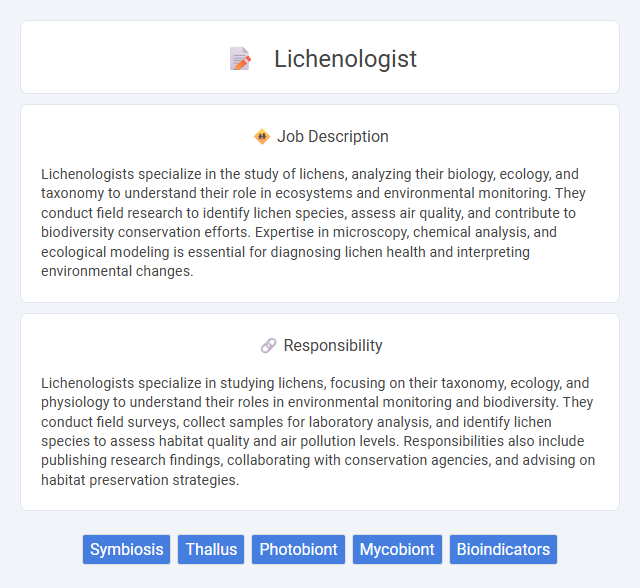
Lichenologists specialize in the study of lichens, analyzing their biology, ecology, and taxonomy to understand their role in ecosystems and environmental monitoring. They conduct field research to identify lichen species, assess air quality, and contribute to biodiversity conservation efforts. Expertise in microscopy, chemical analysis, and ecological modeling is essential for diagnosing lichen health and interpreting environmental changes.
Individuals with a strong interest in nature, particularly in studying symbiotic organisms like lichens, are likely suitable for a lichenologist career. Those who enjoy detailed fieldwork, have patience, and possess skills in microscopy and taxonomy may find this job fulfilling. People prone to outdoor allergies or who dislike repetitive analyses might face challenges in this role.
Qualification
Lichenologists typically require a bachelor's degree in biology, botany, or environmental science, with advanced positions often demanding a master's or Ph.D. specializing in lichenology or mycology. Proficiency in field research, taxonomy, and molecular analysis techniques is essential for studying lichen biodiversity and ecology. Strong skills in microscopy and environmental data interpretation enhance a lichenologist's ability to contribute to conservation and climate change studies effectively.
Responsibility
Lichenologists specialize in studying lichens, focusing on their taxonomy, ecology, and physiology to understand their roles in environmental monitoring and biodiversity. They conduct field surveys, collect samples for laboratory analysis, and identify lichen species to assess habitat quality and air pollution levels. Responsibilities also include publishing research findings, collaborating with conservation agencies, and advising on habitat preservation strategies.
Benefit
Lichenologists likely benefit from contributing to ecological research by studying symbiotic relationships between fungi and algae, which may aid in environmental monitoring and biodiversity conservation. Their expertise could provide valuable insights into climate change impacts and pollution levels, enhancing ecosystem health assessments. Career prospects in academia, environmental agencies, and conservation organizations might offer job stability and opportunities for specialized research funding.
Challenge
Lichenologist jobs likely involve significant challenges related to the identification and classification of diverse lichen species, which often require detailed microscopic analysis and fieldwork in remote or harsh environments. The probability of encountering difficulties in distinguishing between morphologically similar species may be high due to their complex symbiotic nature. Navigating these challenges effectively could demand advanced knowledge in botany, ecology, and chemistry, along with strong problem-solving skills.
Career Advancement
A lichenologist's career advancement often involves progressing from research assistant roles to specialized positions such as senior researcher or curator in botanical gardens or museums. Expertise in taxonomy, ecology, and molecular techniques improves opportunities for leadership in conservation projects and academic appointments. Publishing influential research and securing grants are critical for career growth and recognition in environmental science circles.
Key Terms
Symbiosis
Lichenologists specialize in studying the symbiotic relationship between fungi and photosynthetic partners such as algae or cyanobacteria, which forms lichens. Their research focuses on understanding how this mutualism enables lichens to survive in diverse and extreme environments by exchanging nutrients and providing protection. These experts analyze physiological, genetic, and ecological aspects of symbiosis to reveal insights into biodiversity, bioindication, and climate resilience.
Thallus
Lichenologists specialize in studying the thallus, the vegetative body of lichens, which is crucial for understanding their structure, growth, and ecological roles. Detailed examination of the thallus reveals symbiotic relationships between fungi and algae or cyanobacteria, essential for lichen identification and classification. Expertise in thallus morphology aids in environmental monitoring and biodiversity assessments.
Photobiont
Lichenologists specialize in studying lichens, focusing on the symbiotic relationship between fungi and photobionts, which are photosynthetic partners typically involving algae or cyanobacteria. Understanding photobiont diversity and function is crucial for unraveling lichen ecology, bioindication, and environmental monitoring. Research on photobionts aids in assessing ecosystem health, climate change impact, and potential biotechnological applications.
Mycobiont
Lichenologists specializing in mycobionts study the fungal component of lichens, focusing on the symbiotic relationship between fungi and photosynthetic partners. Their research involves identifying fungal species, analyzing genetic material, and understanding the role of mycobionts in lichen ecology and physiology. Expertise in mycology, molecular biology, and ecological sampling techniques is essential for advancing knowledge of fungal diversity and lichen symbiosis.
Bioindicators
Lichenologists study lichens as vital bioindicators, analyzing their sensitivity to air pollution and environmental changes to assess ecosystem health. Their research provides critical data on pollutant levels, such as sulfur dioxide and heavy metals, aiding in monitoring atmospheric quality and detecting ecological disturbances. Lichenologist expertise supports conservation efforts and informs environmental policies by revealing long-term impacts on biodiversity through lichen population dynamics.
 kuljobs.com
kuljobs.com